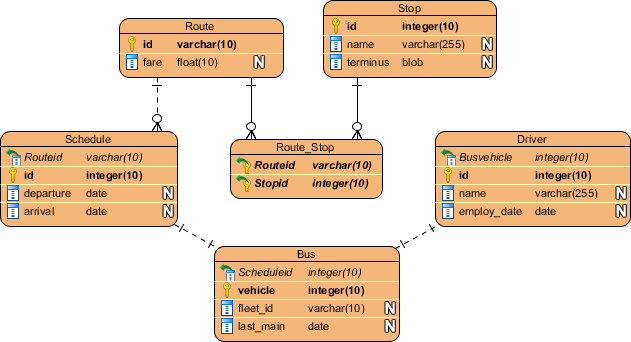Normalisation & ER Diagrams help!
Hello everyone i am really struggling with both normalisation and ER diagrams for ICT and they can end up giving you quite a lot of marks within the exam. I am doing the A2 ICT exam with the CCEA exam board. If anyone could help me that would be really appreciated
Original post by Brolly301
Hello everyone i am really struggling with both normalisation and ER diagrams for ICT and they can end up giving you quite a lot of marks within the exam. I am doing the A2 ICT exam with the CCEA exam board. If anyone could help me that would be really appreciated
Normalisation isn't my forte but I found a useful guide on this.
https://www.sqa.org.uk/e-learning/MDBS01CD/page_26.htm
With regards to ER diagrams, what parts are you struggling with?
"An entity relationship diagram (ERD) is a graphical representation of entities and their relationships to each other, typically used for modeling the organization of data within databases or information systems."

In this example, we have 6 entities containing information regarding bus route management.
- The primary key (indicated by a key) uniquely identifies a record in a database. E.g. each driver has their own ID number, this makes them unique in a database.
- The foreign key (indicated by the green arrow) uniquely identifies a record of another table in the same table, think of it like a reference to another primary key. E.g. each schedule has its own route, which is identified by a route ID in the route table.
- varchar, integer, float, date refers to the datatype for each column, the number in the bracket defines the character length.
- N refers to columns that can contain a NULL value.
Relationships...There are several to take note of here.
- One-to-one relationship: Between bus and schedule. Both tables can have only one record on either side of the relationship. Each bus has its own schedule and each schedule is used by a single bus.
- One-to-many relationship: Between route and schedule. The primary key table contains only one record that relates to none, one, or many records in the related table. A single route may have 1 or more schedules and 1 or more schedules are run by a single route.
- Many-to-many relationship: Between route and stop. Each record in both tables can relate to any number of records (or no records) in the other table. A route may have 1 stop or many stops, at the same time these stops may be present in 1 route or multiple routes. Notice how a third entity is created in a many-to-many relationship, this is known as a linking table or an associative entity.
(edited 6 years ago)
Quick Reply
Related discussions
- WJEC Computer Science A-level
- CS AQA NEA Analysis
- A level biology AQA
- OCR A physics question
- Electrcity Help
- Computer science a level nea help
- Why do I only feel "normal" after a bad injury
- Epq on south Asian women
- quick matlab question
- HNC science
- vectors
- Units help
- Christmas is RUINED News Compilation thread Mk II
- Normal of a cone
- Has anyone met someone from TSR in person?
- For BTEC IT Level 3 unit 1 exam 12 Jan 2024
- HNC Math trig question
- AQA 25 marker structure
- Urgent Isaac physics help !!
- alevel economics exam/essay technique advice plss!
Latest
Last reply 1 minute ago
Official University College London Applicant Thread for 2024Last reply 2 minutes ago
Official London School of Economics and Political Science 2024 Applicant ThreadLast reply 2 minutes ago
Official University of Edinburgh Applicant Thread for 2024Last reply 3 minutes ago
yet to receive a woodhouse interviewLast reply 3 minutes ago
Amazon Project management apprenticeship 2024Last reply 3 minutes ago
Civil Service Fast Stream 2024 - Applicants threadLast reply 5 minutes ago
Official: University of St Andrews A100 Offer Holders 2024 entryPosted 6 minutes ago
MoJ Application status - what does 'on hold' mean?Last reply 9 minutes ago
Can I get an A/A* using claire bio and ms estruch vids for OCR A level biologyLast reply 17 minutes ago
Searching for a KCL Postgrad to take over my accommodation contractLast reply 18 minutes ago
TSR Study Together - STEM vs Humanities!Last reply 18 minutes ago
Official UCL Offer Holders Thread for 2024 entryTrending
Last reply 7 hours ago
Is MathsFM French Alevels good for a CS degree at top uni (OX, UCL, Durham etc)Last reply 1 day ago
OCR A-level Computer Science Paper 1 (H446/01) - 12th June 2023 [Exam Chat]Last reply 1 week ago
OCR A-level Computer Science Paper 2 (H446/02) - 19th June 2023 [Exam Chat]Last reply 3 weeks ago
AQA A-level Computer Science Paper 1 (7517 1A - 1E) - 12th June 2023 [Exam Chat]Last reply 4 weeks ago
Not receiving any response from University of Birmingham.Last reply 3 months ago
OCR GCSE Computer Science Paper 1 (J277/01) - 19th May 2023 [Exam Chat]Last reply 3 months ago
AQA GCSE Computer Science Paper 2 (8525/2) - 25th May 2023 [Exam Chat]Trending
Last reply 7 hours ago
Is MathsFM French Alevels good for a CS degree at top uni (OX, UCL, Durham etc)Last reply 1 day ago
OCR A-level Computer Science Paper 1 (H446/01) - 12th June 2023 [Exam Chat]Last reply 1 week ago
OCR A-level Computer Science Paper 2 (H446/02) - 19th June 2023 [Exam Chat]Last reply 3 weeks ago
AQA A-level Computer Science Paper 1 (7517 1A - 1E) - 12th June 2023 [Exam Chat]Last reply 4 weeks ago
Not receiving any response from University of Birmingham.Last reply 3 months ago
OCR GCSE Computer Science Paper 1 (J277/01) - 19th May 2023 [Exam Chat]Last reply 3 months ago
AQA GCSE Computer Science Paper 2 (8525/2) - 25th May 2023 [Exam Chat]



